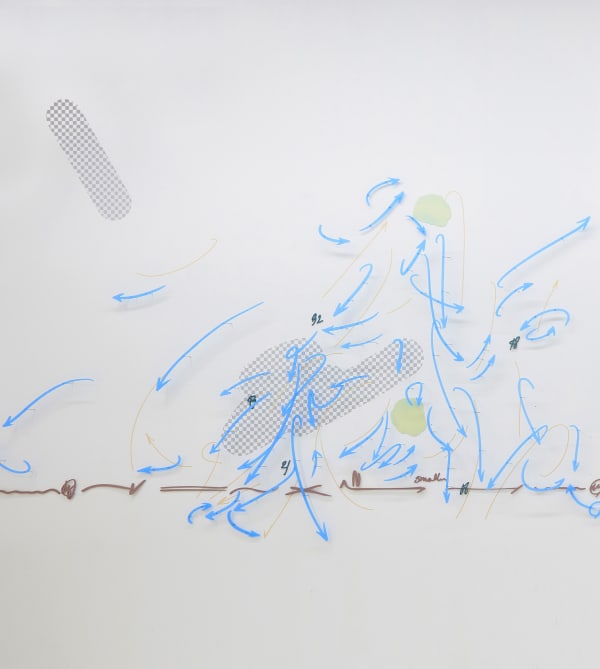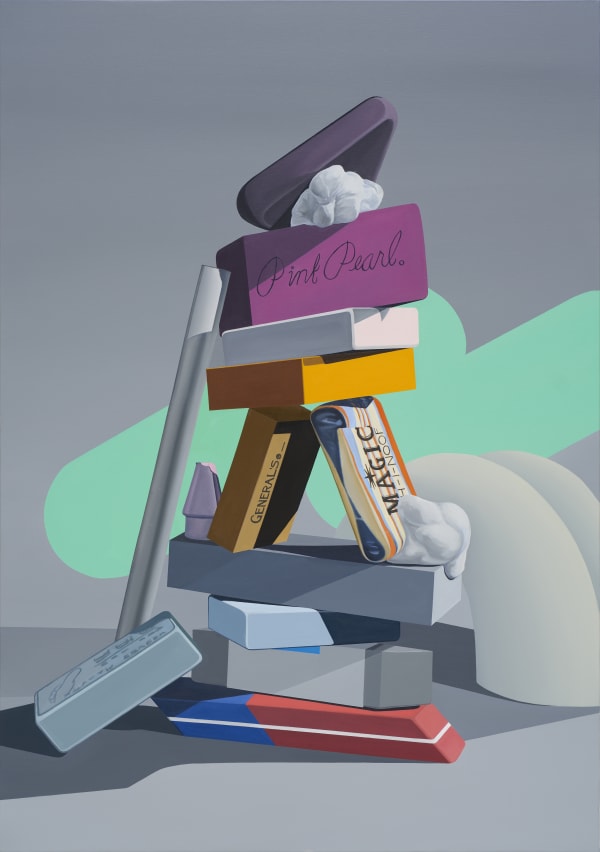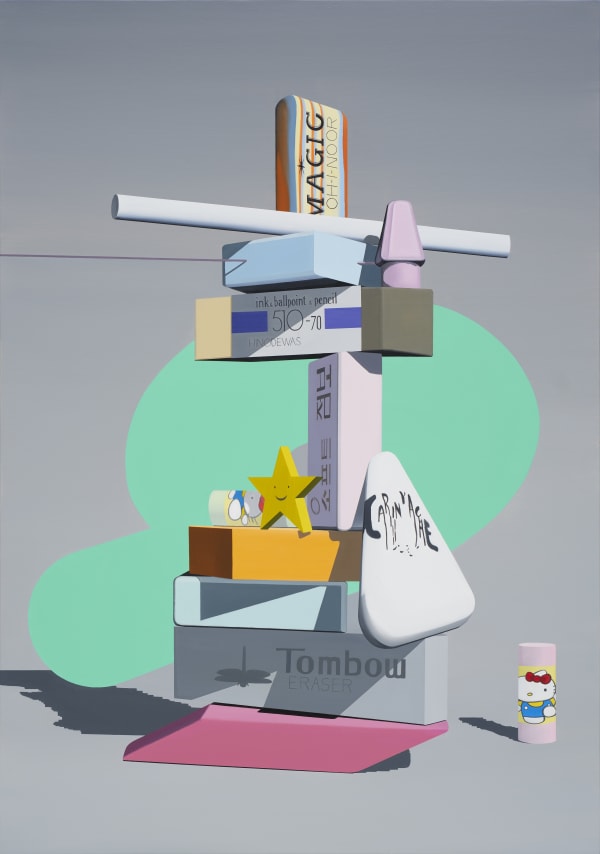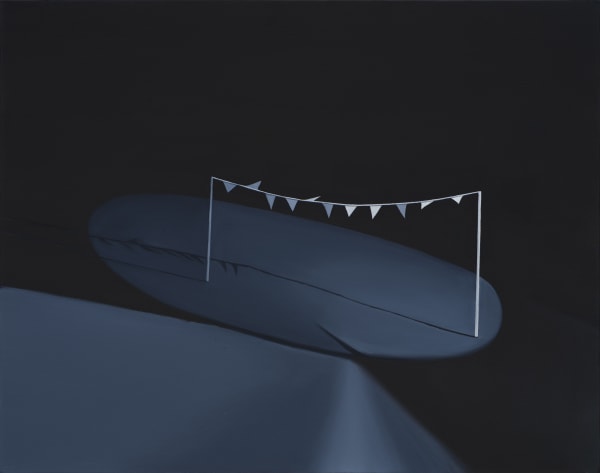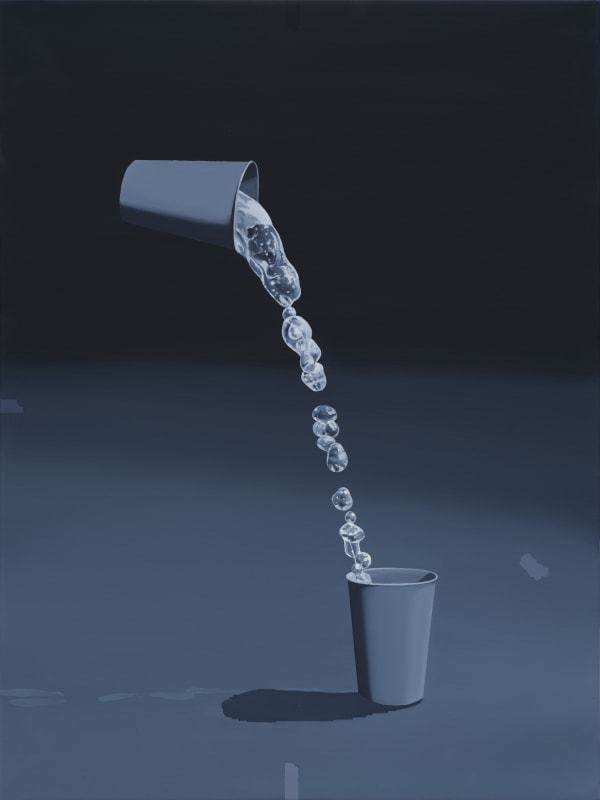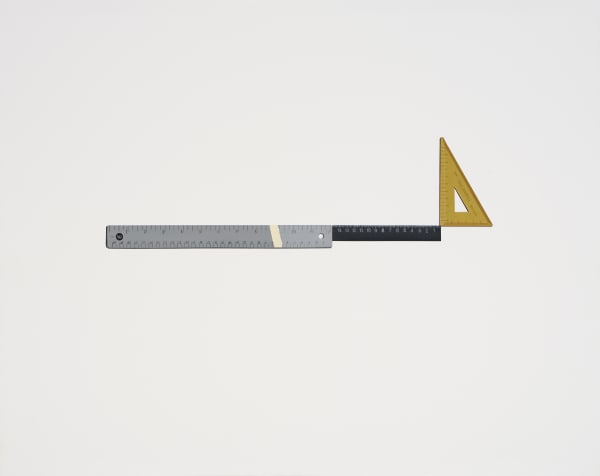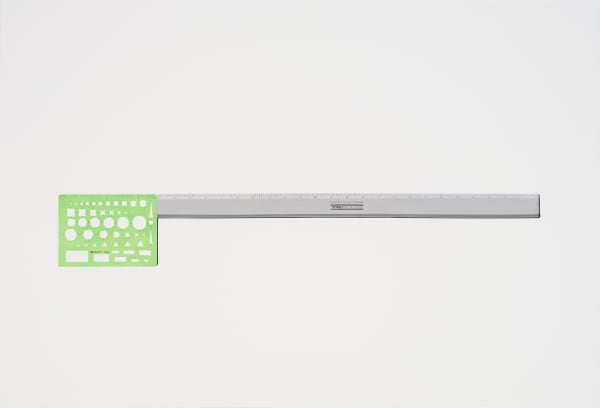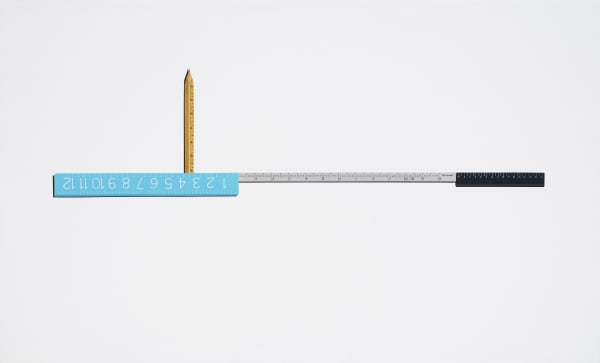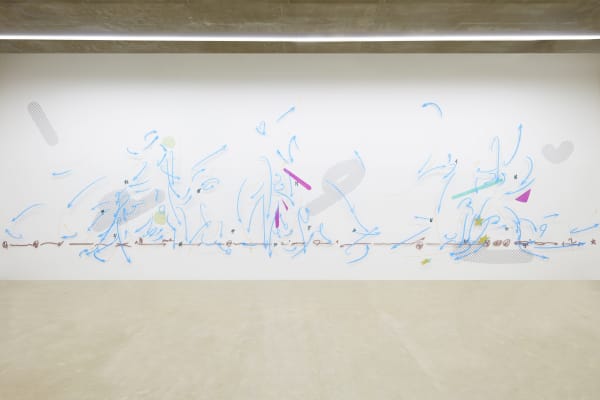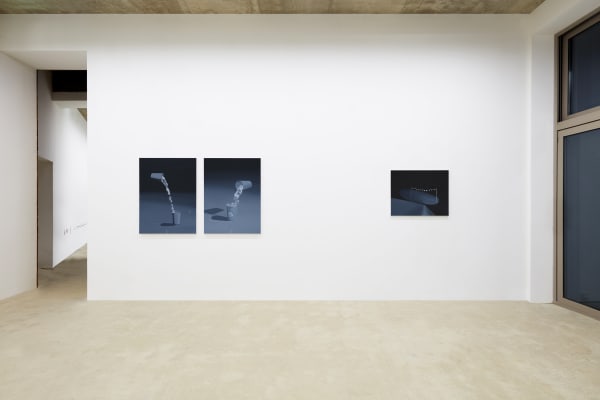새로 고침 Refresh: 홍지연 Jiyon Hong
길거리 떨어진 주인을 알 수 없는 장갑 한 짝은 왜 여기에 떨어져 있을까. 이렇게 낯선 상황과 그 흔적, 임시적인 상황, 언어와 실제 사이의 간극, 내가 알고 있는 것, 알고 있다고 믿었던 것이 사실과 다른 때의 그 아이러니함과 부조리. 홍지연은 자신이 가지고 있는 정서, 유머 그리고 품고 있는 의문을 작품으로 드러낸다. 그 모든 것은 한 인간이 내 자신과 현실에 대해 그가 왜 그것을 부정하고 있는가에 대한 질문이자 그에 대한 대답이다.
홍지연의 개인전 <새로 고침>에서는 설치와 평면 작업을 동시에 선보인다. <Eraser1>, <Eraser2>, <Pencil>은 시네마 4D(Cinema 4D)라는 3D프로그램을 사용해서 실제 사물을 프로그램으로 모델링한 후에 작가가 연출한 장면을 캔버스에 옮겨 담았다. 프로그램을 통한 모델링은 실제 사물이 연출하기 어려운 장면들 즉, 현실의 한계를 벗어나게 하는 수단이다. 그림에는 지우개나 연필과 같은 일상적인 사물이 등장한다. 그는 ‘지우는 것’, ‘새로 고쳐내는 것’을 지우개라는 사물을 통해 담아내고 싶었다고 한다. 흔히 컴퓨터상의 3D프로그램이나 포토샵에서는 ‘새로 고침’의 버튼을 눌러 이미지를 쉽게 지워내거나 원래의 상태로 되돌려 놓을 수 있다. 지우개는 가상의 공간에서 이뤄지는 ‘새로 고침’의 상황을 은유한다. 그럼 연필은? 처음에는 지우개가 달린 연필을 그리고 싶었다고 한다. 그리고 연필은 지우개와 암수 사이니까.
설치 작품인 <Mistake and Fall>은 지우개와 연필을 쌓은 그림에서 파생되었다. 작품은 아래로 낙하하는 방향성을 지시하는 화살표, 첨삭 부호, 3D프로그램이나 포토샵에서 이미지를 지워 냈을 때 보이는 빈 부분으로 구성되어 있다. 홍지연은 3D프로그램에서 모델링 된 지우개와 연필이 무너져 내리는 모습을 영상으로 만들어 사물이 떨어지는 운동감을 화살표로 대체했다. 가상의 공간에서 이뤄진 사물의 구축은 그림으로, 낙하 혹은 새로 고침의 전조는 설치 작품으로 표현된 것이다. 문장을 고치는 첨삭 부호는 이미지가 아닌 언어의 ‘새로 고침’이라고 할 수 있다.
약 10m의 수평선을 이루는 <Horizon>은 길이를 재는 자 드로잉이다. 정확한 치수를 재는 자를 그리면서도 또 수평자를 대고 수평을 맞추는 아이러니한 작가의 경험에서 출발한 작품이다. ‘자로 잰다’는 것은 확인과 검증의 과정이다. 이 역시 의심과 부정을 검증의 과정을 통해 새로 고쳐내려는 태도이다.
이번 전시는 구축, 부정, 낙화, 검증과 첨삭의 과정을 거쳐 ‘새로 고침’으로 점철된다. 그러나 이것은 완벽한 결과물을 목표로 하지 않는다. 그는 (궁극적으로 완벽한) 변화는 불가능하다고 말한다. 현재 상황의 극복을 말하거나 해결책을 제시하기보다는 반복되는 과정 자체를 보여준다. 회화, 드로잉, 설치 작업은 각기 다른 이야기, 더 구체적으로 말하자면 구축, 부정, 낙화, 검증과 첨삭의 단계를 파편적으로 보여줄 뿐입니다. (물론) 작품은 개별적으로 중요하겠지만 작품들 사이의 상황 변화에 주목해야 한다.
홍지연은 기호들이 서로 얽혀있는 상황을 만들고 싶었다고 한다. 이것은 기호의 형태와 의미의 얽힘 모두를 말하는 것이다. 작품 역시 무엇을 의미하는지 정확하게 파악할 수 없고 뭔가를 지시하는 기호를 사용하지만, 아무것도 지시하지 않기를 바란다고 말했다. 그는 작품이 즉각적으로 의미화되는 것을 피하려고 한다. 의미화는 너무 쉽다. 사물이나 인간을 의미화하려고 하는 순간 어쩌면 우리들은 그들로부터 소외를 당하고 있는지 모른다. 우리는 섣부른 의미화를 통해 이미 모든 것을 파악했다고 결론 짓기 때문이다. 만약 그러한 태도를 경계한다면 언어, 기호 그리고 이미지로 정리할 수 있는 것보다 훨씬 다층적인 이야기가 받아들여지지 않을까.
Why are there a pair of gloves dropped on a street, its owner unknown? The paradox and absurdity of this strange situation and its vestiges, the temporary situation, gap between language and reality, what I know perceived as real, and how it is not the truth. Jiyon Hong’s works are vessels of her emotion, humor, and doubts. They culminate into a question and answer of the self, reality, and the why of self-denial.
Jiyon Hong’s solo exhibition Refresh is a presentation of both flat and three-dimensional works. <Eraser1>, <Eraser2>, and <Pencil> were first modeled in 3D, using Cinema 4D, before putting each scene on to the canvas. 3D modeling is a means to transcend reality, to create scenes otherwise impossible with a real-life object. The picture features mundane objects such as erasers and pencils. The artist explains that the intention was to embody in the eraser as an object, the concepts of thing which erases and that which makes anew. 3D modeling programs and photo-editing software makes it very easy to erase images and to return edited images to their original state especially when we click the Refresh button. The eraser is a metaphor for making something anew in a virtual space. The pencil is there, because Hong originally wanted a pencil with a rubber tip, and because the two make a complimentary pair.
<Mistake and Fall> is an installation work that comes from an image of a stack of pencils and erasers. The work consists of a downward arrow, symbols for proofreading and revision, and the empty blankness one can see when an image is erased in 3D modeling programs or photoshop. Jiyon Hong used 3D modeling to add arrows for creating movements of action of stacked pencils and erasers collapse. The construction of objects in virtual space is in painting, and the precursor to falling-and-making-anew is in installation form. The symbols for proofreading and revision are not images but a making-anew of language.
<Horizon> is about 10-meters wide horizontally, a ruler that measures length. It comes from the artist’s experience of drawing with a ruler for accuracy, but again needing a leveler to ensure a horizontal line. To measure with a ruler is to make anew by confirming or verify. That is, to remove any inkling of doubt and suspicion.
The exhibition is summarized in the concept of make anew, via a process of construction, denial, fallout, verification and correction. Perfection is not her aim, and she explains that (perfect) change is not possible. She prefers to avoid discussions of overcoming the present situation or suggest solutions. Rather, she presents a repeating process. Her paintings, drawings, and installations tell different stories, more specifically, fragmented stages of construction, denial, fallout, validation and correction. It goes without saying that the works are important individually, but it is also worth noting the changing circumstances between each work.
Jiyon Hong says she wanted to create a situation where symbols were intertwined. This refers to both the form of symbols and the entanglement of meaning. The artwork is ambiguous about what it may convey, and the unmistakable arrow feels like it symbolizes something, but Hong hopes that it points to nothing particular at all. She wants to avoid any immediate assignment of meaning, because “that would be too easy.” The moment we try to assign meaning to a person, place or thing, we might be alienating ourselves, by assuming that we have comprehended and packed everything about the subject into that meaning. Vigilance against such haste and oversimplification of the subject, the language, the symbol, the image, and some narratives may thrive in the native layers that they are meant to be in.
